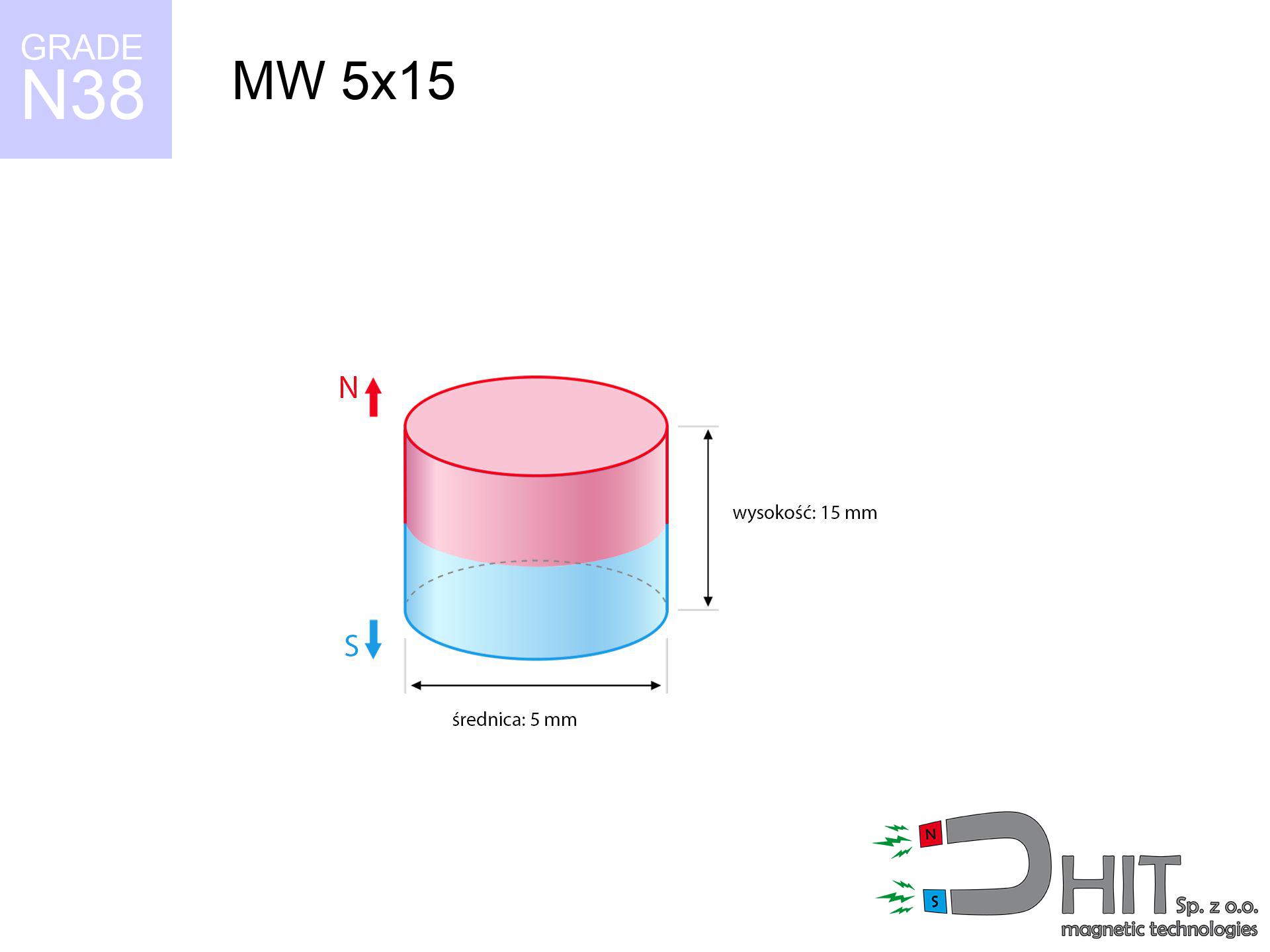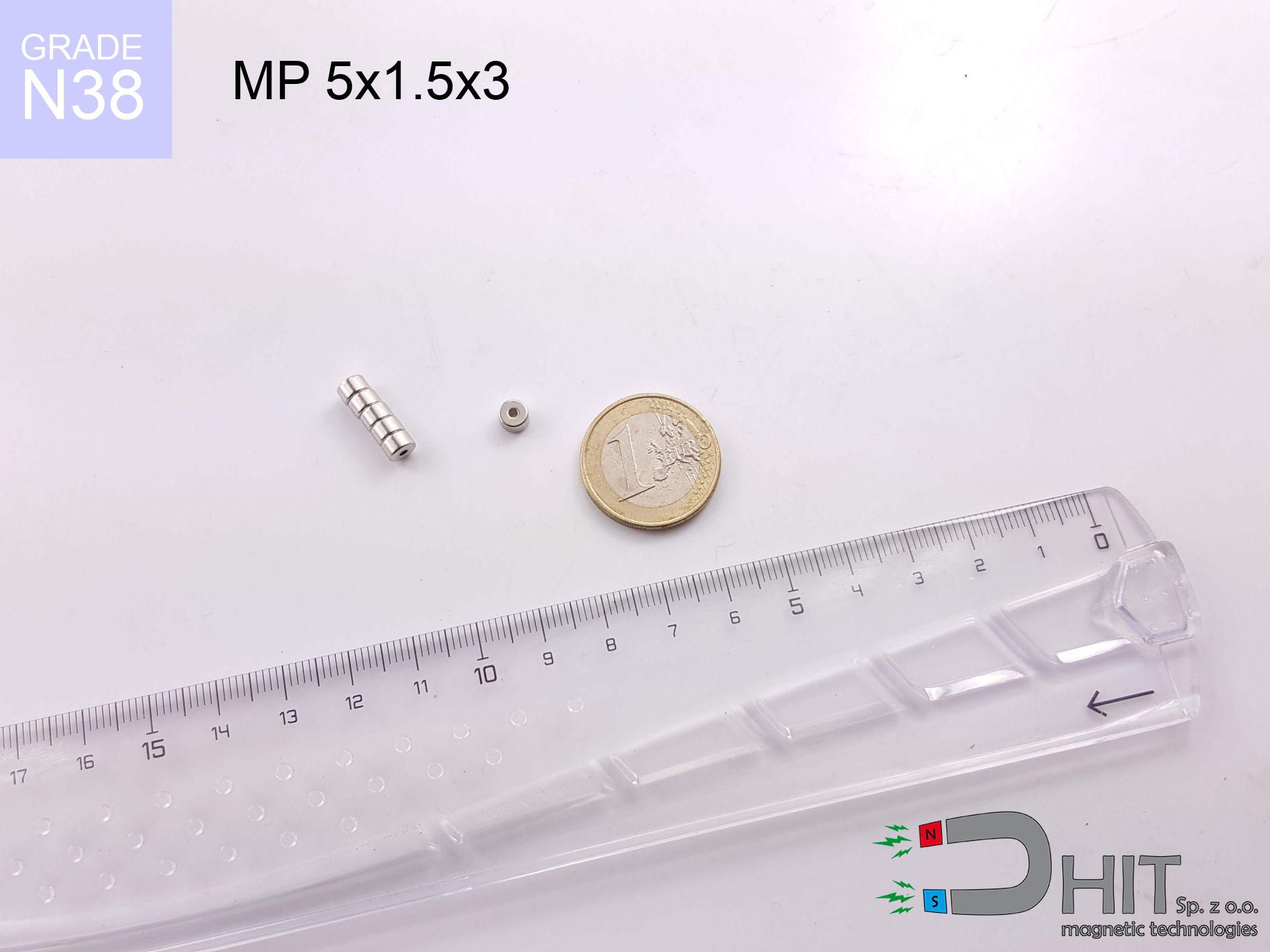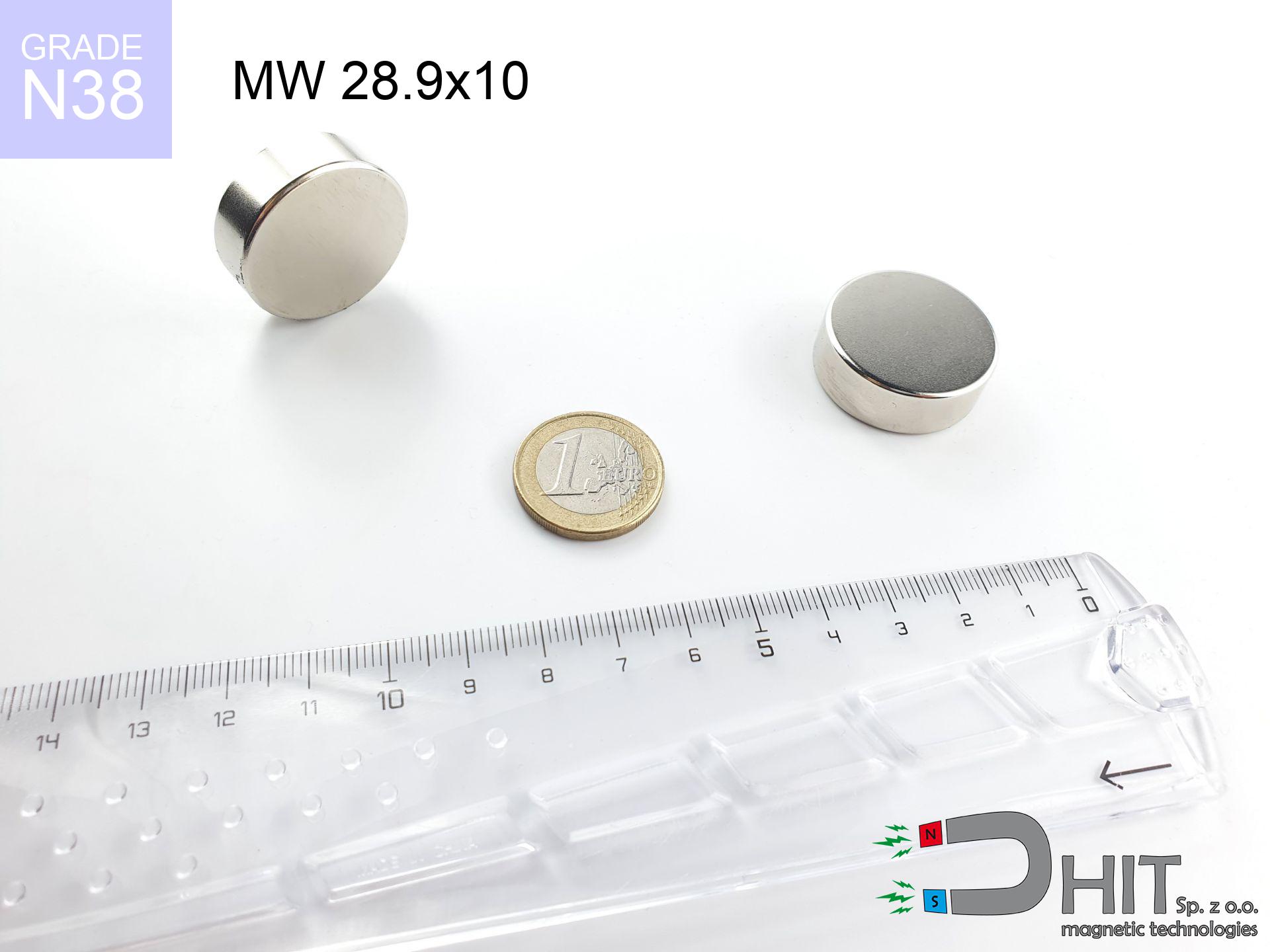MW 5x15 / N38 - cylindrical magnet
cylindrical magnet
Catalog no 010084
GTIN/EAN: 5906301810834
Diameter Ø
5 mm [±0,1 mm]
Height
15 mm [±0,1 mm]
Weight
2.21 g
Magnetization Direction
↑ axial
Load capacity
0.48 kg / 4.68 N
Magnetic Induction
610.03 mT / 6100 Gs
Coating
[NiCuNi] Nickel
1.107 ZŁ with VAT / pcs + price for transport
0.900 ZŁ net + 23% VAT / pcs
bulk discounts:
Need more?
Call us
+48 22 499 98 98
or contact us using
request form
the contact form page.
Parameters as well as structure of magnets can be estimated with our
online calculation tool.
Orders placed before 14:00 will be shipped the same business day.
Technical parameters - MW 5x15 / N38 - cylindrical magnet
Specification / characteristics - MW 5x15 / N38 - cylindrical magnet
| properties | values |
|---|---|
| Cat. no. | 010084 |
| GTIN/EAN | 5906301810834 |
| Production/Distribution | Dhit sp. z o.o. |
| Country of origin | Poland / China / Germany |
| Customs code | 85059029 |
| Diameter Ø | 5 mm [±0,1 mm] |
| Height | 15 mm [±0,1 mm] |
| Weight | 2.21 g |
| Magnetization Direction | ↑ axial |
| Load capacity ~ ? | 0.48 kg / 4.68 N |
| Magnetic Induction ~ ? | 610.03 mT / 6100 Gs |
| Coating | [NiCuNi] Nickel |
| Manufacturing Tolerance | ±0.1 mm |
Magnetic properties of material N38
| properties | values | units |
|---|---|---|
| remenance Br [min. - max.] ? | 12.2-12.6 | kGs |
| remenance Br [min. - max.] ? | 1220-1260 | mT |
| coercivity bHc ? | 10.8-11.5 | kOe |
| coercivity bHc ? | 860-915 | kA/m |
| actual internal force iHc | ≥ 12 | kOe |
| actual internal force iHc | ≥ 955 | kA/m |
| energy density [min. - max.] ? | 36-38 | BH max MGOe |
| energy density [min. - max.] ? | 287-303 | BH max KJ/m |
| max. temperature ? | ≤ 80 | °C |
Physical properties of sintered neodymium magnets Nd2Fe14B at 20°C
| properties | values | units |
|---|---|---|
| Vickers hardness | ≥550 | Hv |
| Density | ≥7.4 | g/cm3 |
| Curie Temperature TC | 312 - 380 | °C |
| Curie Temperature TF | 593 - 716 | °F |
| Specific resistance | 150 | μΩ⋅cm |
| Bending strength | 250 | MPa |
| Compressive strength | 1000~1100 | MPa |
| Thermal expansion parallel (∥) to orientation (M) | (3-4) x 10-6 | °C-1 |
| Thermal expansion perpendicular (⊥) to orientation (M) | -(1-3) x 10-6 | °C-1 |
| Young's modulus | 1.7 x 104 | kg/mm² |
Physical modeling of the product - report
Presented information represent the direct effect of a mathematical analysis. Results were calculated on algorithms for the class Nd2Fe14B. Operational performance might slightly differ from theoretical values. Treat these calculations as a supplementary guide during assembly planning.
Table 1: Static pull force (force vs distance) - interaction chart
MW 5x15 / N38
| Distance (mm) | Induction (Gauss) / mT | Pull Force (kg) | Risk Status |
|---|---|---|---|
| 0 mm |
6091 Gs
609.1 mT
|
0.48 kg / 480.0 g
4.7 N
|
weak grip |
| 1 mm |
3823 Gs
382.3 mT
|
0.19 kg / 189.1 g
1.9 N
|
weak grip |
| 2 mm |
2261 Gs
226.1 mT
|
0.07 kg / 66.1 g
0.6 N
|
weak grip |
| 3 mm |
1378 Gs
137.8 mT
|
0.02 kg / 24.6 g
0.2 N
|
weak grip |
| 5 mm |
607 Gs
60.7 mT
|
0.00 kg / 4.8 g
0.0 N
|
weak grip |
| 10 mm |
154 Gs
15.4 mT
|
0.00 kg / 0.3 g
0.0 N
|
weak grip |
| 15 mm |
63 Gs
6.3 mT
|
0.00 kg / 0.1 g
0.0 N
|
weak grip |
| 20 mm |
32 Gs
3.2 mT
|
0.00 kg / 0.0 g
0.0 N
|
weak grip |
| 30 mm |
12 Gs
1.2 mT
|
0.00 kg / 0.0 g
0.0 N
|
weak grip |
| 50 mm |
3 Gs
0.3 mT
|
0.00 kg / 0.0 g
0.0 N
|
weak grip |
Table 2: Slippage hold (vertical surface)
MW 5x15 / N38
| Distance (mm) | Friction coefficient | Pull Force (kg) |
|---|---|---|
| 0 mm | Stal (~0.2) |
0.10 kg / 96.0 g
0.9 N
|
| 1 mm | Stal (~0.2) |
0.04 kg / 38.0 g
0.4 N
|
| 2 mm | Stal (~0.2) |
0.01 kg / 14.0 g
0.1 N
|
| 3 mm | Stal (~0.2) |
0.00 kg / 4.0 g
0.0 N
|
| 5 mm | Stal (~0.2) |
0.00 kg / 0.0 g
0.0 N
|
| 10 mm | Stal (~0.2) |
0.00 kg / 0.0 g
0.0 N
|
| 15 mm | Stal (~0.2) |
0.00 kg / 0.0 g
0.0 N
|
| 20 mm | Stal (~0.2) |
0.00 kg / 0.0 g
0.0 N
|
| 30 mm | Stal (~0.2) |
0.00 kg / 0.0 g
0.0 N
|
| 50 mm | Stal (~0.2) |
0.00 kg / 0.0 g
0.0 N
|
Table 3: Wall mounting (sliding) - behavior on slippery surfaces
MW 5x15 / N38
| Surface type | Friction coefficient / % Mocy | Max load (kg) |
|---|---|---|
| Raw steel |
µ = 0.3
30% Nominalnej Siły
|
0.14 kg / 144.0 g
1.4 N
|
| Painted steel (standard) |
µ = 0.2
20% Nominalnej Siły
|
0.10 kg / 96.0 g
0.9 N
|
| Oily/slippery steel |
µ = 0.1
10% Nominalnej Siły
|
0.05 kg / 48.0 g
0.5 N
|
| Magnet with anti-slip rubber |
µ = 0.5
50% Nominalnej Siły
|
0.24 kg / 240.0 g
2.4 N
|
Table 4: Steel thickness (saturation) - power losses
MW 5x15 / N38
| Steel thickness (mm) | % power | Real pull force (kg) |
|---|---|---|
| 0.5 mm |
|
0.05 kg / 48.0 g
0.5 N
|
| 1 mm |
|
0.12 kg / 120.0 g
1.2 N
|
| 2 mm |
|
0.24 kg / 240.0 g
2.4 N
|
| 5 mm |
|
0.48 kg / 480.0 g
4.7 N
|
| 10 mm |
|
0.48 kg / 480.0 g
4.7 N
|
Table 5: Working in heat (stability) - resistance threshold
MW 5x15 / N38
| Ambient temp. (°C) | Power loss | Remaining pull | Status |
|---|---|---|---|
| 20 °C | 0.0% |
0.48 kg / 480.0 g
4.7 N
|
OK |
| 40 °C | -2.2% |
0.47 kg / 469.4 g
4.6 N
|
OK |
| 60 °C | -4.4% |
0.46 kg / 458.9 g
4.5 N
|
OK |
| 80 °C | -6.6% |
0.45 kg / 448.3 g
4.4 N
|
|
| 100 °C | -28.8% |
0.34 kg / 341.8 g
3.4 N
|
Table 6: Magnet-Magnet interaction (repulsion) - forces in the system
MW 5x15 / N38
| Gap (mm) | Attraction (kg) (N-S) | Repulsion (kg) (N-N) |
|---|---|---|
| 0 mm |
4.49 kg / 4491 g
44.1 N
6 154 Gs
|
N/A |
| 1 mm |
2.91 kg / 2912 g
28.6 N
9 810 Gs
|
2.62 kg / 2621 g
25.7 N
~0 Gs
|
| 2 mm |
1.77 kg / 1769 g
17.4 N
7 646 Gs
|
1.59 kg / 1592 g
15.6 N
~0 Gs
|
| 3 mm |
1.05 kg / 1046 g
10.3 N
5 880 Gs
|
0.94 kg / 942 g
9.2 N
~0 Gs
|
| 5 mm |
0.37 kg / 372 g
3.7 N
3 507 Gs
|
0.34 kg / 335 g
3.3 N
~0 Gs
|
| 10 mm |
0.04 kg / 45 g
0.4 N
1 213 Gs
|
0.04 kg / 40 g
0.4 N
~0 Gs
|
| 20 mm |
0.00 kg / 3 g
0.0 N
309 Gs
|
0.00 kg / 0 g
0.0 N
~0 Gs
|
| 50 mm |
0.00 kg / 0 g
0.0 N
37 Gs
|
0.00 kg / 0 g
0.0 N
~0 Gs
|
Table 7: Protective zones (electronics) - warnings
MW 5x15 / N38
| Object / Device | Limit (Gauss) / mT | Safe distance |
|---|---|---|
| Pacemaker | 5 Gs (0.5 mT) | 4.5 cm |
| Hearing aid | 10 Gs (1.0 mT) | 3.5 cm |
| Timepiece | 20 Gs (2.0 mT) | 2.5 cm |
| Mobile device | 40 Gs (4.0 mT) | 2.0 cm |
| Car key | 50 Gs (5.0 mT) | 2.0 cm |
| Payment card | 400 Gs (40.0 mT) | 1.0 cm |
| HDD hard drive | 600 Gs (60.0 mT) | 1.0 cm |
Table 8: Impact energy (cracking risk) - warning
MW 5x15 / N38
| Start from (mm) | Speed (km/h) | Energy (J) | Predicted outcome |
|---|---|---|---|
| 10 mm |
14.87 km/h
(4.13 m/s)
|
0.02 J | |
| 30 mm |
25.74 km/h
(7.15 m/s)
|
0.06 J | |
| 50 mm |
33.23 km/h
(9.23 m/s)
|
0.09 J | |
| 100 mm |
47.00 km/h
(13.06 m/s)
|
0.19 J |
Table 9: Anti-corrosion coating durability
MW 5x15 / N38
| Technical parameter | Value / Description |
|---|---|
| Coating type | [NiCuNi] Nickel |
| Layer structure | Nickel - Copper - Nickel |
| Layer thickness | 10-20 µm |
| Salt spray test (SST) ? | 24 h |
| Recommended environment | Indoors only (dry) |
Table 10: Construction data (Flux)
MW 5x15 / N38
| Parameter | Value | SI Unit / Description |
|---|---|---|
| Magnetic Flux | 1 382 Mx | 13.8 µWb |
| Pc Coefficient | 1.38 | High (Stable) |
Table 11: Underwater work (magnet fishing)
MW 5x15 / N38
| Environment | Effective steel pull | Effect |
|---|---|---|
| Air (land) | 0.48 kg | Standard |
| Water (riverbed) |
0.55 kg
(+0.07 kg Buoyancy gain)
|
+14.5% |
1. Sliding resistance
*Note: On a vertical surface, the magnet retains merely ~20% of its max power.
2. Steel saturation
*Thin steel (e.g. computer case) significantly limits the holding force.
3. Power loss vs temp
*For N38 grade, the safety limit is 80°C.
4. Demagnetization curve and operating point (B-H)
chart generated for the permeance coefficient Pc (Permeance Coefficient) = 1.38
This simulation demonstrates the magnetic stability of the selected magnet under specific geometric conditions. The solid red line represents the demagnetization curve (material potential), while the dashed blue line is the load line based on the magnet's geometry. The Pc (Permeance Coefficient), also known as the load line slope, is a dimensionless value that describes the relationship between the magnet's shape and its magnetic stability. The intersection of these two lines (the black dot) is the operating point — it determines the actual magnetic flux density generated by the magnet in this specific configuration. A higher Pc value means the magnet is more 'slender' (tall relative to its area), resulting in a higher operating point and better resistance to irreversible demagnetization caused by external fields or temperature. A value of 0.42 is relatively low (typical for flat magnets), meaning the operating point is closer to the 'knee' of the curve — caution is advised when operating at temperatures near the maximum limit to avoid strength loss.
Elemental analysis
| iron (Fe) | 64% – 68% |
| neodymium (Nd) | 29% – 32% |
| boron (B) | 1.1% – 1.2% |
| dysprosium (Dy) | 0.5% – 2.0% |
| coating (Ni-Cu-Ni) | < 0.05% |
Sustainability
| recyclability (EoL) | 100% |
| recycled raw materials | ~10% (pre-cons) |
| carbon footprint | low / zredukowany |
| waste code (EWC) | 16 02 16 |
Other products
Pros and cons of Nd2Fe14B magnets.
Advantages
- They have constant strength, and over more than ten years their performance decreases symbolically – ~1% (according to theory),
- They do not lose their magnetic properties even under close interference source,
- A magnet with a shiny silver surface has better aesthetics,
- They are known for high magnetic induction at the operating surface, which increases their power,
- Made from properly selected components, these magnets show impressive resistance to high heat, enabling them to function (depending on their form) at temperatures up to 230°C and above...
- Thanks to flexibility in constructing and the capacity to adapt to client solutions,
- Significant place in future technologies – they are utilized in data components, electric motors, medical devices, also industrial machines.
- Relatively small size with high pulling force – neodymium magnets offer impressive pulling force in compact dimensions, which enables their usage in miniature devices
Cons
- To avoid cracks upon strong impacts, we suggest using special steel holders. Such a solution secures the magnet and simultaneously improves its durability.
- Neodymium magnets lose their power under the influence of heating. As soon as 80°C is exceeded, many of them start losing their power. Therefore, we recommend our special magnets marked [AH], which maintain stability even at temperatures up to 230°C
- Due to the susceptibility of magnets to corrosion in a humid environment, we advise using waterproof magnets made of rubber, plastic or other material immune to moisture, in case of application outdoors
- Due to limitations in producing nuts and complex forms in magnets, we propose using a housing - magnetic holder.
- Health risk to health – tiny shards of magnets pose a threat, if swallowed, which becomes key in the context of child health protection. Additionally, small elements of these magnets can complicate diagnosis medical in case of swallowing.
- Due to expensive raw materials, their price is relatively high,
Pull force analysis
Optimal lifting capacity of a neodymium magnet – what contributes to it?
- using a sheet made of high-permeability steel, serving as a magnetic yoke
- possessing a massiveness of at least 10 mm to ensure full flux closure
- with an polished touching surface
- without any clearance between the magnet and steel
- during detachment in a direction perpendicular to the mounting surface
- at standard ambient temperature
Determinants of lifting force in real conditions
- Clearance – existence of foreign body (paint, tape, air) interrupts the magnetic circuit, which reduces power steeply (even by 50% at 0.5 mm).
- Direction of force – maximum parameter is obtained only during perpendicular pulling. The resistance to sliding of the magnet along the surface is standardly several times lower (approx. 1/5 of the lifting capacity).
- Element thickness – for full efficiency, the steel must be adequately massive. Thin sheet restricts the attraction force (the magnet "punches through" it).
- Material composition – different alloys attracts identically. Alloy additives weaken the attraction effect.
- Smoothness – ideal contact is obtained only on smooth steel. Rough texture create air cushions, reducing force.
- Operating temperature – neodymium magnets have a sensitivity to temperature. When it is hot they lose power, and at low temperatures they can be stronger (up to a certain limit).
Holding force was tested on the plate surface of 20 mm thickness, when a perpendicular force was applied, however under parallel forces the holding force is lower. In addition, even a small distance between the magnet’s surface and the plate lowers the load capacity.
Warnings
Do not drill into magnets
Fire warning: Neodymium dust is explosive. Avoid machining magnets without safety gear as this may cause fire.
Product not for children
Strictly keep magnets out of reach of children. Choking hazard is high, and the effects of magnets clamping inside the body are very dangerous.
Power loss in heat
Watch the temperature. Exposing the magnet to high heat will destroy its magnetic structure and strength.
Shattering risk
Protect your eyes. Magnets can fracture upon violent connection, ejecting sharp fragments into the air. Eye protection is mandatory.
Pacemakers
People with a heart stimulator must keep an safe separation from magnets. The magnetism can disrupt the functioning of the life-saving device.
Immense force
Exercise caution. Neodymium magnets attract from a long distance and snap with massive power, often faster than you can react.
Finger safety
Danger of trauma: The attraction force is so immense that it can result in hematomas, pinching, and broken bones. Use thick gloves.
GPS and phone interference
Be aware: neodymium magnets generate a field that confuses precision electronics. Keep a safe distance from your phone, device, and GPS.
Protect data
Equipment safety: Strong magnets can ruin data carriers and delicate electronics (heart implants, medical aids, mechanical watches).
Warning for allergy sufferers
Allergy Notice: The Ni-Cu-Ni coating contains nickel. If redness appears, cease working with magnets and use protective gear.






![HH 42x8.8 [M6] / N38 - through hole magnetic holder HH 42x8.8 [M6] / N38 - through hole magnetic holder](https://cdn3.dhit.pl/graphics/products/hh-42x8.8-m6-hin.jpg)


